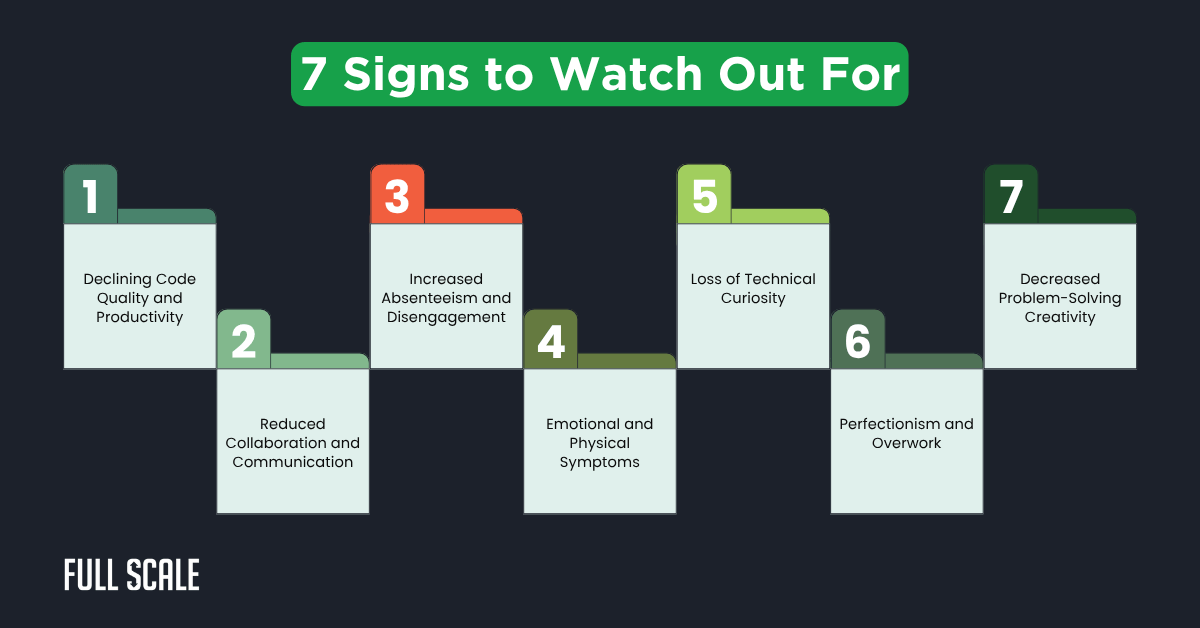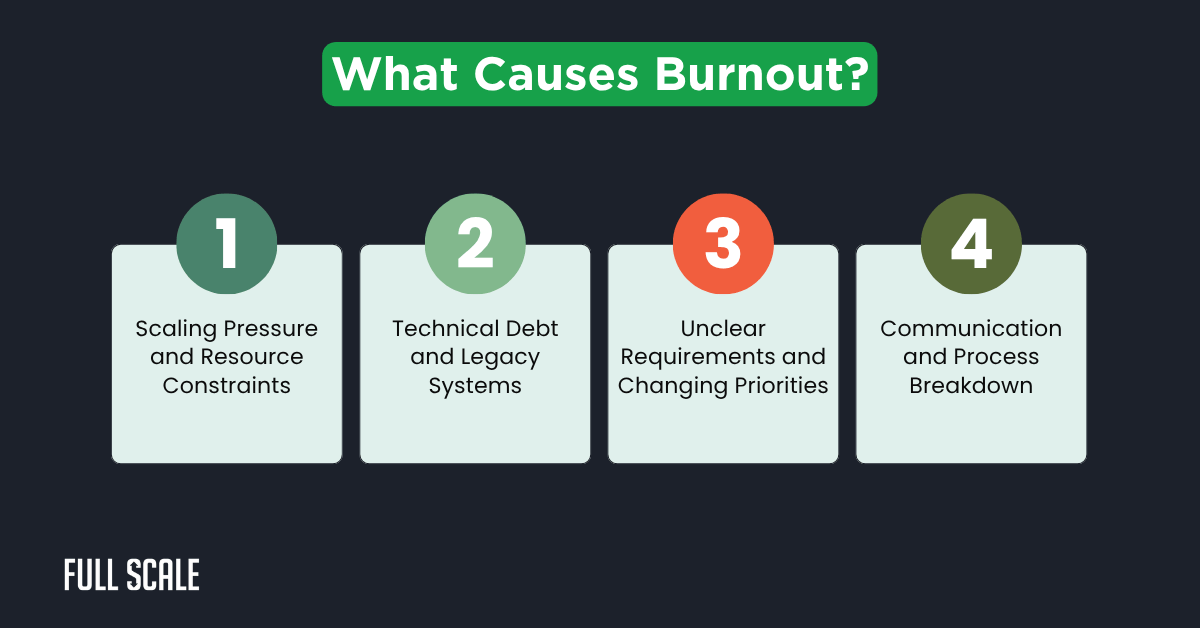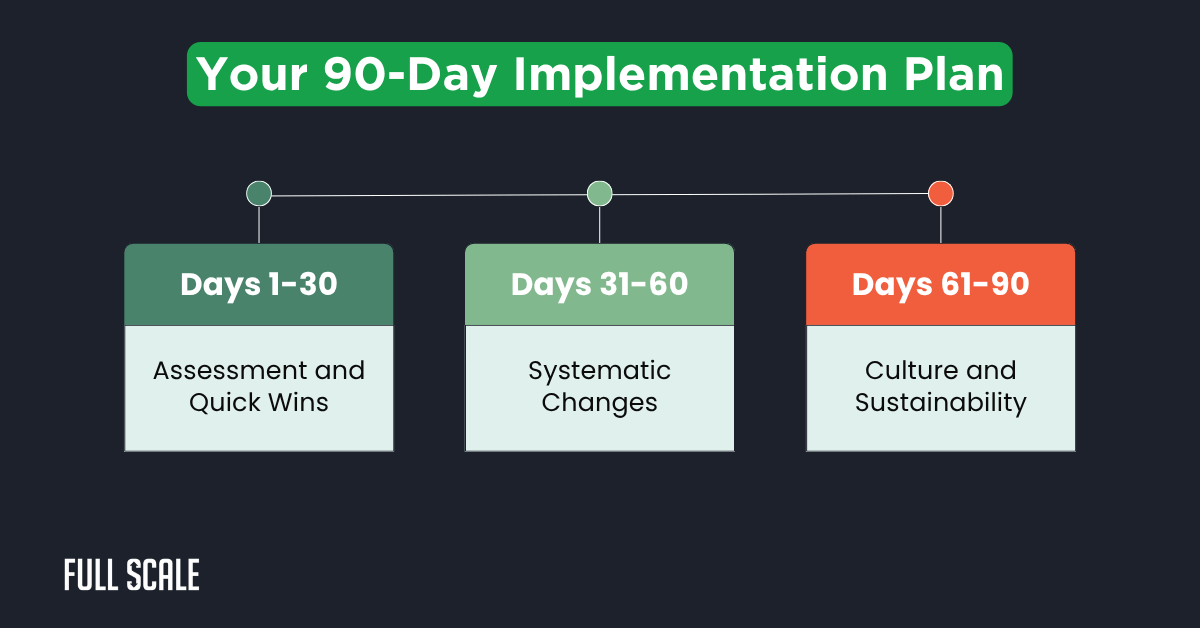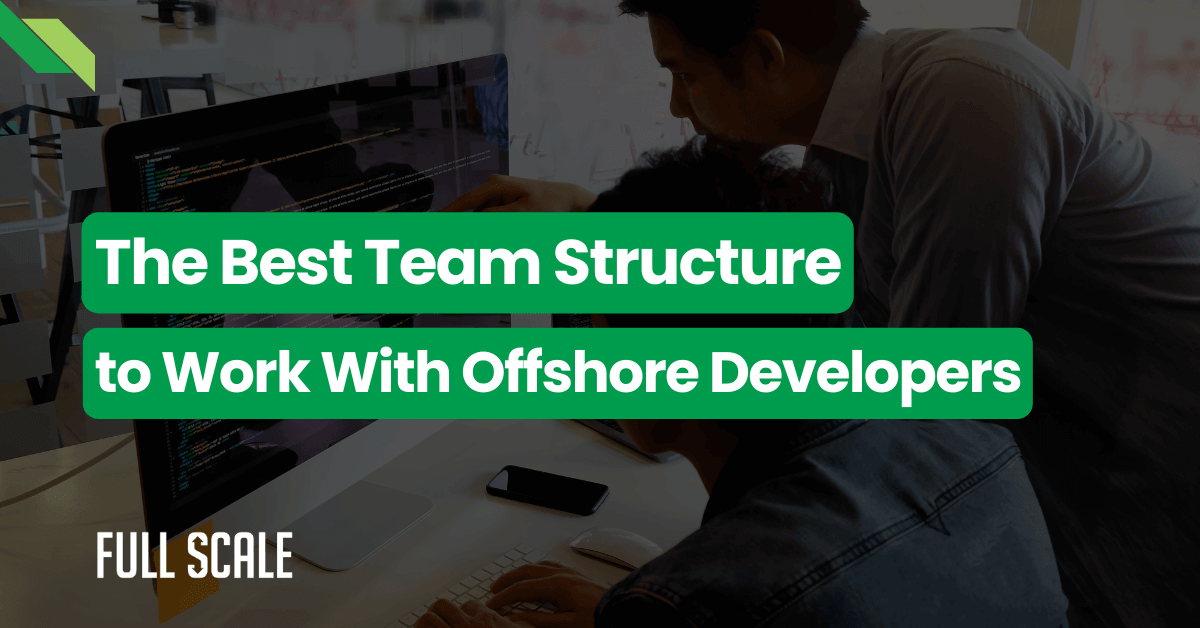Last Updated on 2025-08-26
Your top performer just submitted their two weeks’ notice. Again. The third senior developer to leave in six months, citing “burnout” in their exit interview. Sound familiar?
If you’re an engineering leader struggling with developer retention, declining productivity, or team morale issues, you’re not alone.
Developer burnout costs companies an average of $87,000 per resignation when factoring in recruitment, training, and lost productivity. More critically, it can derail your entire product roadmap and damage your company’s technical foundation.
What Is Developer Burnout?
Developer burnout is a state of physical, emotional, and mental exhaustion caused by prolonged exposure to work-related stress.
Unlike temporary tiredness, burnout fundamentally changes how developers approach their work, leading to:
- Decreased productivity and code quality
- Increased error rates and technical debt
- Reduced collaboration and communication
- Higher absenteeism and turnover
- Loss of passion for technology and problem-solving
The World Health Organization officially recognized burnout as an occupational phenomenon in 2019, and the tech industry has been hit particularly hard. According to recent studies, 83% of software developers report experiencing burnout, with 38% describing it as “highly impactful” to their work performance.
The Hidden Cost of Developer Burnout
Most engineering leaders focus on the obvious costs of developer turnover—recruitment fees and training time.
However, the true financial impact extends far beyond these surface-level expenses. The ripple effects of burnout can fundamentally undermine your company’s technical capabilities and competitive position.
Financial Impact
- Replacement costs: $15,000-$75,000 per developer departure
- Lost productivity: 6-12 months for new hires to reach full productivity
- Knowledge transfer: Critical system knowledge walks out the door
- Project delays: Feature launches pushed back by weeks or months
Technical Debt Acceleration
Burned-out developers often:
- Skip code reviews to meet deadlines
- Write quick fixes instead of sustainable solutions
- Avoid refactoring legacy code
- Reduce test coverage to ship faster
This creates a vicious cycle where technical debt increases stress, leading to more burnout and even more technical debt.
The 7 Warning Signs of Developer Burnout

Early detection is your best defense against the devastating effects of developer burnout. Unlike physical symptoms that are immediately visible, burnout often manifests subtly through changes in behavior, performance, and engagement.
1. Declining Code Quality and Productivity
The first and most measurable sign of developer burnout appears in the code itself.
When talented developers begin producing lower-quality work or taking significantly longer to complete familiar tasks, it’s often an early indicator of mental and emotional exhaustion.
This decline typically occurs gradually, making it easy to attribute to external factors like project complexity or shifting requirements.
What to watch for:
- Increased bug reports and production incidents
- Longer completion times for similar tasks
- Reluctance to take on challenging projects
- More shortcuts in code implementation
How to measure:
- Track code review feedback trends
- Monitor story point completion rates
- Analyze defect density in recent releases
- Review time-to-completion for similar features
2. Reduced Collaboration and Communication
Burnout fundamentally changes how developers interact with their teammates and approach collaborative work.
Previously engaged team members may become withdrawn, offering minimal input during discussions or avoiding opportunities to share knowledge.
This social withdrawal often represents a protective mechanism as burned-out developers attempt to conserve their remaining emotional energy.
What to watch for:
- Minimal participation in team meetings
- Delayed responses to Slack messages or emails
- Avoiding pair programming sessions
- Shorter, less detailed code review comments
Red flag phrases:
- “I don’t care, whatever works”
- “Just ship it”
- “It’s not my problem”
- “I’m too busy to explain”
3. Increased Absenteeism and Disengagement
Physical and mental exhaustion from chronic stress often manifests as increased absence from work or reduced engagement during work hours.
Burned-out developers may start taking more sick days, arriving late, or leaving early as their motivation and energy levels decline.
In remote work environments, this disengagement can be particularly subtle and difficult to detect.
What to watch for:
- More frequent sick days or personal time off
- Arriving late or leaving early consistently
- Multitasking during meetings
- Lack of interest in team activities or company events
Remote work indicators:
- The camera is consistently off during video calls
- Delayed responses during core collaboration hours
- Minimal contribution to team chat channels
- Missing from scheduled pair programming sessions
4. Emotional and Physical Symptoms
Burnout isn’t just a professional issue—it affects developers on a deeply personal level, manifesting in both emotional and physical symptoms.
These changes in mood, energy, and overall demeanor often provide the clearest indicators that stress has moved beyond manageable levels.
As an engineering leader, learning to recognize these human signs of distress is crucial for supporting your team members effectively.
What to watch for:
- Increased irritability or mood swings
- Expressions of feeling overwhelmed or hopeless
- Physical symptoms like headaches or fatigue
- Cynicism about company direction or projects
Conversation patterns:
- Frequent complaints about workload
- Negative comments about management decisions
- Expressing feelings of unappreciation or undervaluation
- Talking about looking for other opportunities
5. Loss of Technical Curiosity
One of the most concerning signs of developer burnout is the loss of intellectual curiosity that originally drew many developers to the field.
When passionate technologists stop exploring new ideas, sharing interesting discoveries, or engaging in technical discussions, it signals a fundamental shift in their relationship with their work.
This loss of curiosity often precedes more serious performance declines and resignation decisions.
What to watch for:
- No longer sharing interesting articles or technologies
- Avoiding learning new tools or frameworks
- Resistance to technical discussions
- Preference for familiar solutions over innovative approaches
Cultural indicators:
- Stopped contributing to tech talks or brown bags
- No longer participating in architecture discussions
- Avoiding conference attendance or industry events
- Decreased activity on professional social media
6. Perfectionism and Overwork
Paradoxically, some developers respond to burnout by working harder rather than less, developing perfectionist tendencies, and taking on excessive responsibilities.
This counterintuitive response often stems from a fear of failure or loss of control, leading high-performing developers to micromanage themselves and others.
What to watch for:
- Working excessive hours regularly
- Difficulty delegating tasks
- Obsessing over minor details
- Taking on too many responsibilities
Paradoxical signs:
- High performers suddenly become controlling
- Experienced developers micromanage junior team members
- Insistence on handling critical tasks personally
- Resistance to code reviews or feedback
7. Decreased Problem-Solving Creativity
The cognitive demands of software development require sustained mental energy and creative thinking.
When burnout sets in, developers often lose their ability to approach problems with fresh perspectives or innovative solutions.
What to watch for:
- Relying heavily on copy-paste solutions
- Avoiding complex architectural decisions
- Difficulty breaking down large problems
- Preference for quick fixes over thoughtful solutions
Technical indicators:
- Increased dependency on Stack Overflow for basic problems
- Less innovative solutions to recurring issues
- Avoiding refactoring opportunities
- Reduced contribution to technical planning sessions
The Root Causes of Developer Burnout

While recognizing the symptoms of burnout is important, addressing the underlying causes is essential for long-term prevention.
Most developer burnout stems from systemic organizational issues rather than individual character flaws or poor work habits.
1. Scaling Pressure and Resource Constraints
The pressure to scale engineering teams rapidly while maintaining quality and meeting aggressive deadlines creates a perfect storm for developer burnout.
Many growing companies are caught between investor expectations for rapid growth and the practical limitations of hiring and integrating technical talent.
The Challenge
- Rapid company growth demanding 50-100% team expansion
- Existing developers stretched thin training new hires
- Competition for senior talent driving up costs
- Pressure to deliver more with the same resources
The Burnout Cycle
- Company growth accelerates feature demands
- Existing team works overtime to compensate
- Quality suffers, leading to more bugs and rework
- Stress increases, performance decreases
- Top performers leave, increasing pressure on the remaining team
2. Technical Debt and Legacy Systems
Accumulated technical debt creates a frustrating work environment. When developers spend more time fighting their tools and systems than building new features, job satisfaction plummets and stress levels soar.
Legacy systems that lack proper documentation, testing, or modern architecture patterns can turn even experienced developers into stressed, inefficient workers.
The Problem
- Accumulated shortcuts and quick fixes
- Legacy systems that are difficult to maintain
- Outdated tools and development processes
- Poor documentation and knowledge transfer
The Impact
- Simple changes require disproportionate effort
- Developers feel frustrated by system limitations
- Fear of breaking things leads to conservative development
- Innovation stagnates due to technical constraints
3. Unclear Requirements and Changing Priorities
Constant scope changes, unclear acceptance criteria, and shifting priorities create an environment of perpetual uncertainty that exhausts developers mentally and emotionally.
When developers invest significant effort in features that get cancelled or substantially modified, they experience a sense of wasted effort that erodes motivation.
Common Scenarios
- Sales promising features without engineering input
- Product management is changing priorities weekly
- Unclear acceptance criteria leading to rework
- Lack of technical requirements in feature specs
Developer Frustration
- Wasted effort on cancelled features
- Constant context switching between projects
- Difficulty planning and estimating work
- Feeling like their expertise isn’t valued
4. Communication and Process Breakdown
Inefficient communication patterns and poorly designed development processes can transform productive developers into frustrated, overworked team members.
Excessive meetings, unclear escalation paths, and time zone management challenges all contribute to stress and reduced productivity.
Remote Work Challenges
- Time zone differences are causing async delays
- Reduced informal communication and mentoring
- Difficulty reading team dynamics and stress levels
- Over-reliance on meetings for collaboration
Process Issues
- Too many meetings reduce coding time
- Inefficient code review processes
- Manual deployment and testing procedures
- Lack of clear escalation paths for blockers
Top 5 Strategic Prevention Framework
Preventing developer burnout requires a comprehensive, systematic approach addressing immediate symptoms and underlying causes.
Effective prevention strategies must be integrated into your organization’s culture, processes, and daily operations rather than treated as standalone wellness initiatives.
1. Build Sustainable Scaling Practices
Rapid team growth is one of the primary triggers for developer burnout, but it doesn’t have to be.
The key is implementing best team scaling practices, prioritizing knowledge transfer, cultural integration, and sustainable workload distribution.
Implement Gradual Team Growth
- Hire 2-3 developers per quarter rather than 10 at once
- Ensure each new hire has a dedicated mentor
- Create structured onboarding programs (30-60-90 day plans)
- Document tribal knowledge before it walks out the door
Optimize for Knowledge Transfer
- Implement pair programming for critical system components
- Create architectural decision records (ADRs)
- Establish code ownership rotation policies
- Build comprehensive technical documentation
Resource Allocation Strategies
- Use the 70-20-10 rule: 70% feature work, 20% technical debt, 10% exploration
- Implement “innovation time” for creative problem-solving
- Rotate developers between different projects and domains
- Create specialized teams for complex technical challenges
2. Establish Comprehensive Health Monitoring
Proactive team health monitoring requires more than tracking velocity and bug counts. It demands systematic attention to the human elements of software development.
Effective health monitoring combines quantitative metrics with qualitative insights to warn early about burnout risks. The goal is to create feedback loops that allow you to identify and address problems before they escalate into resignations or performance crises.
Implement Team Health Metrics
- Developer satisfaction surveys (quarterly)
- Code review turnaround time tracking
- Deployment frequency and failure rates
- Time spent in meetings vs. coding
Create Early Warning Systems
- Weekly one-on-ones with structured questions
- Anonymous feedback channels
- Peer recognition and feedback systems
- Workload distribution analysis
Sample Health Check Questions
- “What’s the most frustrating part of your work right now?”
- “What would make you 20% more productive?”
- “How confident are you in our current technical direction?”
- “What’s one thing you’d change about our development process?”
3. Optimize Development Processes
Inefficient development processes are silent productivity killers that gradually wear down even the most motivated developers.
Process optimization should focus on minimizing context switching, reducing wait times, and streamlining repetitive tasks that distract from meaningful development work.
Reduce Context Switching
- Implement “no meeting” days for focused work
- Batch similar tasks together
- Use asynchronous communication for non-urgent items
- Create dedicated time blocks for deep work
Improve Code Review Efficiency
- Set clear review turnaround expectations (24-48 hours)
- Use automated tools for style and basic quality checks
- Implement review checklists for consistency
- Rotate review responsibilities to prevent bottlenecks
Streamline Deployment and Testing
- Implement continuous integration and deployment
- Automate testing at multiple levels
- Create staging environments that mirror production
- Use feature flags for safer deployments
4. Address Technical Debt Strategically
Technical debt is often treated as an inevitable byproduct of rapid development, but this mindset creates unnecessary stress and inefficiency for development teams.
A strategic approach to technical debt management involves systematic identification, prioritization, and remediation of issues impacting developer productivity and product quality.
Create a Technical Debt Inventory
- Document known issues and their business impact
- Estimate the effort required for fixes
- Prioritize based on risk and development friction
- Allocate dedicated time for debt reduction
Implement Debt Prevention Practices
- Require architecture reviews for major features
- Establish coding standards and enforce them
- Regular refactoring sessions
- Post-mortem analyses for production issues
Balance Feature Work with Maintenance
- Reserve 20% of sprint capacity for technical improvements
- Celebrate technical debt reduction as much as feature delivery
- Include technical debt in product roadmap discussions
- Measure and communicate the impact of technical improvements
5. Enhance Communication and Collaboration
Clear, efficient communication is the foundation of healthy development teams, yet many organizations struggle with communication patterns that create more stress than clarity.
Effective communication enhancement involves improving the quality of information sharing and reducing the overhead of collaboration.
Improve Requirements Clarity
- Implement user story acceptance criteria templates
- Require technical requirements for complex features
- Create shared glossaries for domain-specific terms
- Establish definition-of-done checklists
Optimize Meeting Culture
- Audit all recurring meetings for necessity
- Implement standing meeting agendas
- Use asynchronous updates when possible
- Create meeting-free zones for focused work
Build Effective Remote Collaboration
- Establish core collaboration hours across time zones
- Use shared documentation for decision-making
- Implement virtual coffee chats and team building
- Create clear escalation paths for blockers
Implementation Roadmap: 90-Day Burnout Prevention Plan
Implementing comprehensive burnout prevention requires a structured, phased approach that balances immediate relief with long-term systematic changes.
This 90-day roadmap provides a practical framework for transforming your engineering culture while maintaining productivity and team morale.

Days 1-30: Assessment and Quick Wins
The first month focuses on understanding your current situation and implementing immediate interventions that provide relief without requiring major organizational changes.
This phase establishes baseline measurements that will help you track progress while introducing practices that demonstrate your commitment to addressing burnout.
The goal is to create positive momentum and begin building trust with your team members who may be skeptical about yet another management initiative.
Week 1: Baseline Assessment
- Conduct an anonymous team burnout survey
- Review recent turnover and exit interview data
- Audit the current meeting load and development processes
- Identify the top 3 technical debt items
Week 2: Immediate Interventions
- Implement “no meeting Wednesdays” for focused work
- Establish a 24-hour code review turnaround commitment
- Create an anonymous feedback channel
- Start weekly one-on-ones with structured questions
Week 3: Process Improvements
- Introduce story point estimation calibration
- Implement a technical debt tracking system
- Create a shared team calendar for deep work blocks
- Establish clear escalation procedures
Week 4: Communication Enhancement
- Launch weekly team retros with burnout focus
- Create a technical discussion forum/channel
- Implement async daily standups for remote teams
- Start monthly all-hands technical presentations
Days 31-60: Systematic Changes
The second month focuses on implementing more substantial process improvements and structural changes that address the root causes of burnout.
These systematic changes require more coordination and planning but provide a deeper, longer-lasting impact on team health and productivity.
This phase often reveals additional areas for improvement as you begin to see how different aspects of your development process interact and influence each other.
Week 5-6: Workflow Optimization
- Implement automated testing and deployment pipelines
- Create a development environment setup automation
- Establish a code review checklist and guidelines
- Launch the peer programming rotation program
Week 7-8: Resource Allocation
- Implement 70-20-10 work allocation rule
- Create an innovation time for creative projects
- Establish technical debt reduction sprints
- Launch knowledge sharing initiatives
Days 61-90: Culture and Sustainability
The final month concentrates on embedding burnout prevention into your organizational culture and establishing systems to maintain progress over time.
Cultural change takes longer than process improvements, but it’s essential for creating lasting transformation.
This phase focuses on building habits, rituals, and expectations that will sustain healthy team dynamics even as your organization continues to grow and evolve.
Week 9-10: Team Building
- Implement cross-team collaboration projects
- Create technical mentorship programs
- Launch internal tech talks and brown bags
- Establish team recognition and celebration rituals
Week 11-12: Long-term Systems
- Create a career development planning process
- Implement a comprehensive performance feedback system
- Establish a team health dashboard
- Launch a continuous improvement program
Advanced Strategies for Resilient Teams
Beyond basic burnout prevention, truly resilient engineering teams require advanced strategies that build anti-fragility—the ability to not just survive stress but actually grow stronger from challenges.
These approaches go beyond simply preventing negative outcomes to actively cultivating positive team dynamics, continuous learning, and adaptive capacity.
Building Anti-Fragile Engineering Culture
Creating a culture that thrives under pressure requires intentionally designing systems, processes, and norms that encourage growth through challenge rather than breakdown under stress.
Anti-fragile cultures view failure as a learning opportunity, embrace uncertainty as a catalyst for innovation, and build redundancy into critical systems.
Psychological Safety Initiatives
- Blameless post-mortems for production issues
- “Failure parties” to celebrate learning from mistakes
- Open discussion about technical challenges
- Encouragement of experimentation and risk-taking
Continuous Learning Programs
- Conference attendance budgets for all developers
- Internal tech talks and knowledge sharing
- Dedicated time for skill development
- Cross-training on different technologies and domains
Autonomy and Ownership
- Give developers a choice in technology selection
- Implement feature ownership with end-to-end responsibility
- Allow flexible work arrangements and schedules
- Encourage participation in technical decision-making
Leveraging Team Augmentation for Scaling
Strategic use of external talent can provide relief for overburdened internal teams while maintaining quality and cultural cohesion.
Strategic Use of External Resources
- Augment with specialized skills for specific projects
- Use offshore teams for development capacity scaling
- Implement hybrid models combining internal and external talent
- Create knowledge transfer protocols for external team integration
Maintaining Team Cohesion
- Establish clear communication protocols across all team members
- Implement shared coding standards and practices
- Create an inclusive team culture that welcomes external contributors
- Regular team-building activities, including remote team members
Measuring Success: KPIs for Burnout Prevention
Effective burnout prevention requires systematic measurement and continuous improvement based on data-driven insights.
However, measuring team health involves both quantitative metrics that track observable behaviors and qualitative assessments that capture the human experience of work.
Quantitative Metrics
Numbers provide objective benchmarks for tracking progress and identifying trends over time, but selecting the right metrics requires careful consideration of what behaviors and outcomes you want to encourage.
The goal is to create dashboards that provide actionable insights for continuous improvement.
Team Health Indicators
- Developer satisfaction scores (target: >7/10)
- Voluntary turnover rate (target: <10% annually)
- Time to fill open positions (target: <60 days)
- Internal promotion rate (target: >20% annually)
Productivity Metrics
- Sprint commitment accuracy (target: >80%)
- Code review turnaround time (target: <24 hours)
- Deployment frequency (target: daily)
- Mean time to recovery from incidents (target: <2 hours)
Quality Indicators
- Defect density in production (target: <0.1 per KLOC)
- Technical debt ratio (target: <30%)
- Code coverage percentage (target: >80%)
- Customer satisfaction scores (target: >8/10)
Qualitative Assessments
While numbers provide important benchmarks, the human experience of work can only be understood through qualitative methods that capture subjective experiences, emotions, and perceptions.
Regular Pulse Surveys
- Monthly team mood surveys
- Quarterly comprehensive burnout assessments
- Semi-annual 360-degree feedback sessions
- Annual culture and engagement surveys
Observational Indicators
- Participation in voluntary activities
- Contribution to technical discussions
- Initiative in proposing improvements
- Mentorship and knowledge-sharing behavior
The ROI of Burnout Prevention
Investing in comprehensive burnout prevention delivers measurable returns across multiple dimensions of business performance, from direct cost savings to competitive advantages in talent acquisition and retention.
While some benefits are immediately quantifiable, others provide strategic value that compounds over time.
Cost Savings
- Reduced recruitment and training costs
- Lower healthcare and wellness program utilization
- Decreased project delays and rework
- Improved customer satisfaction and retention
Productivity Gains
- Higher feature delivery velocity
- Improved code quality and maintainability
- Faster problem resolution and innovation
- Enhanced team collaboration and knowledge sharing
Competitive Advantages
- Stronger employer brand and talent attraction
- Higher employee referral rates
- Improved customer trust and satisfaction
- Enhanced ability to tackle complex technical challenges
Building Sustainable Engineering Excellence
Developer burnout isn’t just an HR problem—it’s a strategic business risk that can derail your company’s technical roadmap and competitive position.
By implementing comprehensive prevention strategies, you can build resilient engineering teams that deliver exceptional results while maintaining high job satisfaction and retention.
Key Takeaways
- Monitor proactively: Implement early warning systems to catch burnout before it impacts performance.
- Address root causes: Focus on systemic issues like technical debt, unclear requirements, and resource constraints.
- Invest in processes: Streamline development workflows and reduce friction in daily work.
- Build culture: Create psychological safety, continuous learning, and meaningful work.
- Measure and iterate: Track both quantitative metrics and qualitative indicators of team health.
Remember, preventing burnout isn’t a one-time initiative—it’s an ongoing commitment to creating an environment where developers can do their best work sustainably. Investing time and resources will pay dividends in team performance, innovation, and business results.
Take Action Today
- Conduct a burnout assessment with your team
- Identify your top 3 systemic issues contributing to stress
- Implement one quick win from the 30-day action plan
- Schedule regular check-ins to monitor progress
Your developers are your most valuable asset. Protecting their well-being isn’t just the right thing to do—it’s essential for building the technical excellence your company needs to succeed.
Hire Developers without Worrying About Burnout
People Also Ask About Developer Burnout
Understanding developer burnout requires addressing the most common questions and concerns that engineering leaders face when dealing with team stress and retention issues.
How long does it take to recover from developer burnout?
Recovery from developer burnout typically takes 3-6 months with proper intervention and support. The timeline depends on the severity of burnout, individual resilience factors, and the quality of the recovery environment provided. Mild burnout may resolve in 6-8 weeks with workload adjustments and process improvements, while severe cases requiring time off may need 4-6 months for full recovery. Key recovery factors include reduced workload, improved work-life balance, meaningful work assignments, and strong management support.
Can remote work cause developer burnout?
Depending on implementation and management practices, remote work can both contribute to and help prevent developer burnout. Risk factors include social isolation, communication overload, boundary blurring between work and personal life, and difficulty accessing mentorship. However, remote work can reduce burnout by eliminating commutes, flexible schedules, and reduced office distractions. The key is establishing clear communication protocols, maintaining social connections, and providing proper remote work support and equipment.
What’s the difference between developer burnout and normal work stress?
Normal work stress is temporary and situational, while burnout is chronic and pervasive. Work stress typically resolves after completing challenging projects or meeting deadlines, whereas burnout persists regardless of workload changes. Stress can enhance performance in short bursts, but burnout consistently degrades performance, creativity, and job satisfaction. Burnout also affects personal life and physical health more significantly than typical work stress, requiring systematic intervention rather than rest and recovery.
How do you talk to a burned-out developer without making it worse?
Approach burned-out developers with empathy, active listening, and a focus on solutions rather than blame. Start conversations by acknowledging their contributions and expressing genuine concern for their well-being. Ask open-ended questions about their challenges and listen without immediately offering solutions. Avoid minimizing their concerns or comparing them to other team members. Focus on what you can change rather than what they need to do differently, and follow up consistently on your commitments during these conversations.
Should you hire more developers or use offshore teams to prevent burnout?
The answer depends on your specific situation, budget, and timeline. Hiring locally provides better cultural integration and communication, but takes 60-90 days and costs $15K to $75K per hire. Offshore teams can provide immediate capacity relief at lower costs but require strong management and communication processes. Staff augmentation with specialized offshore developers often provides the best balance, offering specific skills without long-term hiring commitments while reducing pressure on existing team members.
What are the early warning signs that your entire engineering team is at risk?
Team-wide burnout risk indicators include declining sprint completion rates across multiple developers, increased production incidents and technical debt, reduced participation in team activities and discussions, higher-than-normal sick leave usage, and multiple team members expressing job dissatisfaction. Cultural warning signs include increased conflict between team members, resistance to new initiatives, cynicism about company direction, and loss of innovation and creative problem-solving across the team.
Frequently Asked Questions About Developer Burnout Prevention
These questions represent engineering leaders’ most common concerns when implementing burnout prevention strategies. Each answer provides actionable guidance you can implement immediately while building comprehensive long-term solutions.
Q: How much should we budget for developer burnout prevention initiatives?
A: Effective burnout prevention typically costs 2-5% of your total engineering budget but delivers 300-500% ROI through reduced turnover and improved productivity. A $2M annual engineering budget should allocate $40K to $100K for burnout prevention, including team health monitoring tools ($5K to $15K annually), process improvement initiatives ($10K to $25K), wellness programs ($10K to $20K), and training for engineering managers ($5K to $15K). This investment is significantly less than the $87K average cost of replacing a single burned-out developer.
Q: Can you prevent burnout while maintaining aggressive development timelines?
A: Yes, but it requires strategic process optimization and realistic scope management. Focus on reducing waste and inefficiency rather than increasing work hours. Implement automated testing and deployment to reduce manual overhead, establish clear priorities to minimize context switching, and use time-boxing to prevent perfectionism. Most importantly, involve engineering teams in timeline estimation to ensure realistic commitments. Aggressive timelines become sustainable when supported by efficient processes and adequate resources.
Q: How do you measure developer burnout in remote teams?
A: Remote burnout measurement requires more intentional monitoring than in-office teams. Use weekly pulse surveys with specific questions about workload, stress levels, and job satisfaction. Track behavioral indicators like response times to messages, participation in video calls, and contribution to team discussions. Implement regular one-on-one meetings with structured check-ins, monitor work hours through time-tracking tools, and watch for changes in code quality and productivity metrics. Create anonymous feedback channels for team members to report concerns.
Q: What’s the best way to handle a developer who’s already burned out?
A: Immediate intervention focuses on workload reduction and stress relief. Temporarily reassign urgent tasks to other team members, provide time off if needed, and work with the developer to identify specific stressors. Create a recovery plan with reduced responsibilities, meaningful but manageable work assignments, and regular check-ins to monitor progress. Consider professional counseling resources through team member assistance programs. Most importantly, the systemic issues that caused the burnout should be addressed to prevent recurrence.
Q: How long does it take to see results from burnout prevention efforts?
A: Initial improvements in team morale and stress levels typically appear within 2-4 weeks of implementing quick wins like meeting reduction and process improvements. Measurable changes in productivity, code quality, and retention rates usually emerge after 60-90 days of consistent effort. Cultural changes and long-term resilience building require 6-12 months to fully establish. The key is maintaining consistent effort and measuring both leading indicators (team satisfaction) and lagging indicators (turnover rates) to track progress.
Q: Should engineering managers be responsible for preventing developer burnout?
A: Engineering managers play a crucial role, but burnout prevention requires organization-wide commitment. Managers are responsible for monitoring team health, facilitating workload management, and advocating for their teams with upper management. However, executives must provide adequate resources, realistic timelines, and support for burnout prevention initiatives. Product managers must collaborate on realistic scope setting, and HR must provide wellness resources and policies. Successful burnout prevention is a shared responsibility across the entire organization.
Q: How do you prevent burnout when using offshore development teams?
A: Offshore team burnout prevention requires attention to communication, cultural integration, and equitable treatment. Establish overlapping work hours for real-time collaboration, provide the same development tools and resources as local teams, and include offshore developers in team meetings and cultural activities. Avoid treating offshore teams as “code factories” by involving them in architectural decisions and product planning. Regular video calls, clear documentation, and cultural sensitivity training help build strong working relationships that prevent isolation and frustration.
Q: What’s the ROI timeline for developer burnout prevention investments?
A: ROI from burnout prevention typically becomes positive within 6-12 months and compounds over time. Initial investments in process improvements and team health monitoring show returns through reduced recruitment costs and improved productivity within the first year. Long-term benefits, including enhanced employer brand, higher team member referral rates, and improved innovation capacity, continue growing yearly. Most engineering organizations see 300-500% ROI within 24 months when implementing comprehensive burnout prevention strategies.

Matt Watson is a serial tech entrepreneur who has started four companies and had a nine-figure exit. He was the founder and CTO of VinSolutions, the #1 CRM software used in today’s automotive industry. He has over twenty years of experience working as a tech CTO and building cutting-edge SaaS solutions.
As the CEO of Full Scale, he has helped over 100 tech companies build their software services and development teams. Full Scale specializes in helping tech companies grow by augmenting their in-house teams with software development talent from the Philippines.
Matt hosts Startup Hustle, a top podcast about entrepreneurship with over 6 million downloads. He has a wealth of knowledge about startups and business from his personal experience and from interviewing hundreds of other entrepreneurs.




